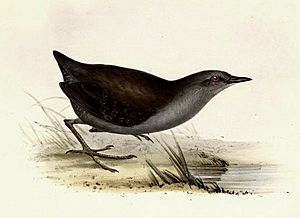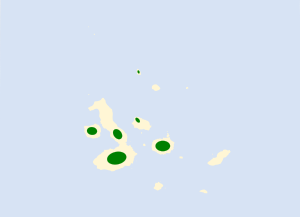Galapagos crake facts for kids
Quick facts for kids Galápagos crake |
|
|---|---|
 |
|
| Conservation status | |
| Scientific classification | |
| Genus: |
Laterallus
|
| Species: |
spilonota
|
 |
|
| Synonyms | |
|
|
The Galápagos crake (Laterallus spilonota) is a small, shy bird. It is also known as the Galápagos rail or Darwin's rail. This bird is a Vulnerable species, meaning it needs our help to survive.
It belongs to the rail family, which includes birds like gallinules and coots. The Galápagos crake is special because it lives only on the Galápagos Islands. It looks a lot like its close relative, the black rail, which lives in the Americas. These two birds became different species about 1.2 million years ago.
Contents
About the Galápagos Crake
What's in a Name?
Scientists have given the Galápagos crake many different names over time. Its current scientific name is Laterallus spilonota. Some experts even thought it was a type of black rail. But now, it is known as its own unique species.
What Does It Look Like?
The Galápagos crake is a small bird, about 15 cm (6 inches) long. It weighs around 35 to 45 grams (1.2 to 1.6 ounces). Both male and female crakes look alike.
Adult crakes have a dark gray head and chest. Their sides and upper legs have thin white stripes. Their back is a pretty chestnut brown color. The lower back and tail are dark brown. Their eyes are a bright, distinctive red! Their beak, legs, and toes are dark brown.
Young crakes look a bit different. They are mostly dark brown with a lighter brown back. Their face and throat might be slightly grayish.
Where Do They Live?
The Galápagos crake lives on several Galápagos Islands. These include Pinta, Fernandina, Isabela, Santiago, Santa Cruz, San Cristóbal, and Floreana. Sadly, the populations on San Cristóbal and Floreana might no longer exist.
These birds prefer to live in the wet, high parts of the islands. They like areas with lots of thick ferns, bushes, and other plants. This dense cover helps them hide and find food.
Life and Habits
How They Move
The Galápagos crake stays on the islands all year round. It can fly and swim, but it's not very good at either! Its flight looks a bit clumsy. When danger is near, this bird usually chooses to run away rather than fly.
What Do They Eat?
Galápagos crakes look for food during the day. They walk along the ground in thick plants. They often toss leaves aside to look for hidden treats. Their favorite foods are insects of many kinds. They also eat other small creatures like spiders, snails, and even berries and seeds.
Reproduction and Family Life
The breeding season for the Galápagos crake seems to be from September to April. These birds are very protective of their homes. If another crake comes too close, they might stomp their feet and raise their tail as a warning!
Pairs stay together during the breeding season. They build their nests on the ground. The nest is a cup-shaped home made of plants, partly covered with a side entrance. A female crake usually lays three to six eggs. Both parents take turns sitting on the eggs for about 23 to 25 days. After the chicks hatch, it takes about 80 to 85 days for them to grow into adults.
What Sounds Do They Make?
The Galápagos crake makes at least five different sounds. These include "cheeping," a "chichichichiroo" call, a "chirr" call, a chatter, and a rattle call. They use these sounds for different reasons. Some calls help family members stay in touch. Others are used to mark their territory or scare away predators.
Protecting the Galápagos Crake
The International Union for Conservation of Nature (IUCN) now lists the Galápagos crake as a "Vulnerable" species. This means their numbers are decreasing. There are an estimated 3,300 to 6,700 adult crakes left.
Several things threaten these birds:
- Habitat Loss: Animals like cattle, goats, and pigs can destroy the plants where crakes live. When these animals were removed from Santiago Island, the crake population grew back!
- Climate Change: Changes in weather can affect the crake's home.
- Predators: Wild rats, cats, and dogs can hunt the crakes. Even native short-eared owls can be a threat.
Protecting their habitat and controlling introduced animals are important steps to help the Galápagos crake survive.
See also
 In Spanish: Polluela de las Galápagos para niños
In Spanish: Polluela de las Galápagos para niños


